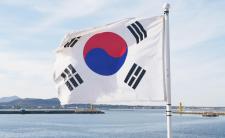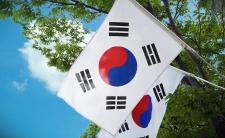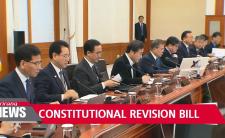Last updated in April 2018
Background Constitutional History
The Constitution of the Republic of Korea is the supreme law of the Republic of Korea (South Korea). Between 17 July 1948, the date of adoption of the first Constitution, and 1987, the Constitution was amended nine times and six republics were established. South Korea adopted its current democratic constitution on 29 October 1987.
The 1948 constitution established a system where the president was elected by the national assembly. The first amendment in 1952 was enacted during Rhee Syngman and introduced a directly elected president and a bicameral parliament, despite initial proposals to establish a parliamentary system. Rhee Syngman was reelected the following year. Syngman subsequently amended the constitution in November 1954 to remove term limits to allow him to run again, following mathematical maneuvers where the 2/3 majority required was approximated to the integer closest to the exact figure. In exact figures, a 2/3 majority meant support from 135.33 members of parliament out of the total 203 members. The amendment only received 135 votes. The government argued that the 2/3 majority was achieved as 135 was the closest integer to 135.33. The unlimited term for the presidency in this controversial amendment was to apply only to the first president of the Republic.
Following the popular protests and student revolution in response to rigged elections in 1960, which eventually led to the resignation of Syngman, the constitution was amended in June 1960 to introduce a parliamentary system of government, constituting the Second Korean Republic. This was followed by another amendment in November 1960 which, in response to popular demands for punitive measures, allowed the retroactive punishment of those guilty of election irregularities, corruption and appropriation of public property-under the inclusive designation of ‘anti-democratic’ acts.
The fifth amendment to the constitution in December 1962 gave birth to the Third Republic. The then newly installed government proved incapable of asserting its authority following the departure of strong man Syngman. This precipitated a military coup in December 1962, led by Park Chung-Lee. The military junta dissolved parliament. While the constitution theoretically continued in force, the emergency law had precedence. The ruling junta established a committee to draft a new constitution. Public hearings and panel discussions were held on a nationwide basis and findings were referred to the Supreme Military Council for final review before the draft Constitution was put to a referendum. The presidential system was retained in the new Constitution. The token public engagement in the drafting process was aimed at countering the prevailing complaint that the regime was dictatorial and enjoyed little popular support.
The ruling party undertook another (sixth) constitutional amendment in October 1969 to authorize a third term for the general turned President Park Chung-Lee. Despite strong resistance from the opposition, the amendment was passed in the Assembly and approved in a referendum.
President Park, then in his third term, suddenly invoked martial law, ostensibly in anticipation of a projected North-South Korean dialogue in December 1972. The constitution was suspended and the National Assembly was dissolved by an extra-constitutional power. Soon the State Council, temporarily substituting the Assembly, took up a constitutional amendment bill, which was approved with 91.5% in a referendum, launching the Fourth Republic. This constitution brought about the so-called ‘Yusin Ch'eje’ (Restoration Order). Under this constitution, ostensibly designed to expedite reunification and to give legal backing to what was claimed to be the ‘Korean style democracy’, the president was vested with nearly unlimited powers overriding the other separate branches of government: he was free to serve as many terms as the National Congress for Reunification may decide; he could name one-third of the members of the National Assembly and dissolve the legislature; he could appoint judges, including the chief justice, and; he was authorized to issue extraordinary measures which could suspend constitutional provisions.
Process of Adoption of the 1987 (current) Constitution
The ‘Restoration Order’ came to a sudden end with the assassination of the president. Another coup was staged in the ensuing interregnum. On the initiative of the interim president, a new amendment was drafted by the Constitution Deliberation Committee operating under the prime minister, and approved in a referendum in October 1980, establishing the current and Fifth Korean Republic. Under this Constitution, the president would serve only one seven-year term. Although the extension of the presidential term was possible by constitutional amendment, such a change would not apply to the president in office. This explicit prohibition of constitutional amendment for extended rule was a distinctive component of the new constitution. True, the new constitution removed many undesirable provisions in the Restoration Order Constitution; but it still conferred a vast authority on the president. In form, the Constitution of the Fifth Republic was drafted according to established legal processes. Under martial law, however, political activity was banned and freedom of speech suppressed.
The constitution was amended in 1987 as a result of the people’s aspiration for enhanced democracy. The proposed amendment was submitted to the National Assembly on 18 September 1987, passed at the legislature on 12 October, confirmed through a public referendum on October 27 with 93%, and finally promulgated on 25 February 1988. This amendment was achieved through government-opposition collaboration, for the first time in Korean constitutional history. In this sense, the constitution has more legitimacy than does any earlier amendment. Pivotal in this amendment is the election of a president by direct popular vote, restored after a 15-year aberration of indirect vote. The president is to serve only one five-year term. The power of the legislature is strengthened, and individual rights are further protected under the constitution. While the powers of the legislature were boosted to allow it to check the executive branch, the extensive presidential powers remain, tilting the balance in favor of the latter. The constitution has not been amended since 1987.
Recent Constitution Reform Efforts
There is growing public demand for revising ‘the 1987 Constitution’, which is in reality an amendment to the former constitution. Most of all, South Korea has yet to find the best balance for the executive power under a hierarchical political tradition. In 2016 and 2017, the political scandal that led to the removal of President Park’s from office revived a long-simmering argument that constitutional reform is necessary to reduce the president’s powers. Due to the extensive powers of the presidency, Korean politicians are obsessed with winning in the presidential election and becoming the ‘ruling party’. Rather than engaging in dialogue and compromise with the opposing party, elected presidents rely on informal toolboxes, i.e., patronage politics, clientelist favoritism and regional loyalties, to ultimately win legislative support. Furthermore, the president can neutralize political opponents through his ‘political weapons’ namely, the Prosecutor General, the Chief of the Police Agency, the Chairman of the Board of Audit and Inspection (BAI), and the Commissioner of National Tax Service. Thus, South Korean presidents exercise concentrated and personalized presidential power, undermining democratic political institutions. While also proposing the reduction of the powers of the president and the enhancement of the powers of parliament and the prime minister, there is also strong support for the removal of the prohibition on reelection. The permission of reelection is said to allow incumbents to deliver with a view of renewing their mandate and also address the challenge where single term presidents lose political steam in the last years of their term.
Moreover, the current court structure is too overbearing and authoritative. Recently, there have been allegations that the National Court Administration (NCA) kept a secret list of judges and their political orientations and used it as a gauge for decisions on promotion. Under the current system, the president nominates the Chief Justice of the Supreme Court who then de facto appoints court justices and all other judges. Simultaneously, the independence and expertise of institutions such as the Board of Audit and Inspection (BAI), the Prosecutor General, and Commissioner of National Tax Service must be stepped up to better protect the rights of the public.
In addition, the reform proposal is likely to open possibilities for other reforms. There are some rights that exist in theory but have yet to be incorporated into case law that should be added to the constitution, such as right to live (safely), the related rights to information, rights of consumers, right to conscientious objection, right of asylum, etc. There is also proposals for the decentralization of powers and the inclusion of mechanisms for direct democracy to allow citizens to propose laws.
The System of Government in the Current Constitution
Consisting of a preamble, 130 articles, and supplementary provisions, the constitution provides for an executive branch headed by a president and an appointed prime minister, a unicameral legislature called the National Assembly, and a judiciary consisting of the Constitutional Court, Supreme Court and lower courts.
The Legislature
The constitution vests legislative power in the unicameral National Assembly, which consists of at least 200 members. Currently, it has 300 seats. Three-quarters are elected from single-member districts for a term of four years. The remaining members are appointed through a proportional allocation of seats to political parties. The latest election was held in 2016, and the next election will be in 2020. The National Assembly elects a speaker and two deputy speakers, which in reality means that the majority party determines who the speaker will be. The Assembly can override presidential vetoes with a two-thirds majority.
The Executive
The president, who is the head of state and government, is elected by direct popular election once every five years through the first-past-the-post plurality system and cannot serve more than one term. The president cannot dissolve the National Assembly and is also prohibited from issuing emergency decrees covering the whole range of state affairs. However, the president can still proclaim martial law and grant amnesty. Upon the proclamation of martial law, the president must notify the National Assembly without delay. If the Assembly requests the lifting of martial law with an absolute majority of its total membership, the president must comply. The president appoints a cabinet consisting of no more than thirty posts for the State Council, among them a prime minister and a deputy prime minister. The appointment of the prime minister requires the consent of the National Assembly. The president and the central bureaucracy continue to be the dominant forces in South Korean policymaking through the presidential authority to table bills before the legislature, which outnumber the number of bills proposed by the legislature itself, and through decrees. The National Assembly can propose to the president the dismissal of the prime minister and state ministers. The recommendation is not binding.
The Judiciary
The judicial branch consists of the Constitutional Court, the Supreme Court, and lower courts, such as the Family Court and the District Courts. The president appoints the Chief Justice and other justices of the Supreme Court upon the recommendation of the Chief Justice and with the consent of the National Assembly. Judges other than the Supreme Court justices are appointed by the Chief Justice with the consent of the Conference of Supreme Court Justices. There is no jury system.
In particular, the Constitutional Court was formally established in September 1988. Based on the European model, it is a specialized court that exclusively determines (1) the constitutionality of laws upon the referral of regular courts; (2) impeachment; (3) the dissolution of a political party up on the request of the government; (4) competence disputes between central government agencies, between central government agencies and local governments, and between local governments; and (5) constitutional complaints as prescribed by law. Notably, decisions of the Court on the unconstitutionality of a law, impeachment, dissolution of a political party, and constitutional complaints require the concurrence of at least six of the nine judges.
The nine members of the Constitutional Court are appointed for a renewable six-year term by the president (three members), the National Assembly (three members), and the Chief Justice (three members). The head of the Court is appointed by the president with the consent of the National Assembly.
System of Government under the 1987 Constitution
|
Branch |
Hierarchy |
Appointment |
Powers |
Removals |
|
Executive |
President |
Direct popular election through the first-past-the-post system. President serves a single five-year term. |
|
|
|
Prime Minister (PM) |
Appointed by the president with the consent of the National Assembly (NA)
|
|
|
|
|
State Council (Cabinet) |
|
Deliberating on important national policies that fall within the power of the Executive |
|
|
|
Legislature |
National Assembly
|
|
|
End of four-year term. |
|
Judiciary |
Supreme Court |
|
Hears appeals from decision by second level of district courts or appeals from decision of High Courts. |
|
|
High Court |
Appointed by the Chief Justice with the consent of the Conference of Supreme Court Justices. |
Functioning as court of first appellate court as well as those cases designated by law. |
|
|
|
District Court (Family court, etc.) |
Primarily courts of general original jurisdiction, hearing both criminal and civil cases. |
|||
|
Constitutional Court |
Consisting of nine members: appointed by the president (3 members), the National Assembly (3 members), and the Chief Justice (3 members). |
|
|
Timeline
1945 After World War II, Japanese occupation ends with Soviet troops occupying area north of the 38th parallel, and US troops in the south.
1948 Republic of Korea proclaimed.
1950 South declares independence, sparking North Korean invasion.
1953 Armistice ends Korean War, which cost two million lives.
1950s South sustained by crucial US military, economic and political support.
1960 President Syngman Ree steps down after student protests against electoral fraud. New constitution forms Second Republic, but political freedom remain limited.
1961 Military coup puts General Park Chung-hee in power.
1963 General Park restores some political freedom and proclaims Third Republic. Major programme of industrial development begins.
1972 Martial law. Park increases his powers with constitutional changes.
1979 Park assassinated. General Chun Doo-hwan seizes power the following year.
1980 Martial law declared after student demonstrations. In the city of Gwangju, army kills at least 200 people. Fifth Republic and new constitution.
1981 Chun indirectly elected to a seven year term. Martial law ends, but government continues to have strong powers to prevent dissent.
1986 Constitution is changed to allow direct election of the president.
1987 President Chun pushed out of office by student unrest and international pressure in the build-up to the Sixth Constitution. General Roh Tae-woo succeeds President Chun, grants greater degree of political liberalisation and launches anti-corruption drive.
1988 First free parliamentary elections. Olympic games in Seoul.
1993 President Roh succeeded by Kim Young Sam, a former opponent of the regime and the first freely-elected civilian president.
2002 December - Roh Moo-hyun, from governing Millennium Democratic Party, wins closely-fought presidential elections.
2007 December - Conservative Lee Myung-bak wins landslide victory in presidential election.
2012 July - South Korea begins move of most ministries to ‘mini capital’ at Sejong City, 120km south of Seoul. Key ministries will remain in Seoul.
2012 December - South Korea elects its first female president, Park Geun-hye, of the conservative Saenuri party. She takes office in February.
2014 April - Sewol ferry sinks off west coast, killing at least 281 people, mainly high-school students.
2014 December - Constitutional Court bans left-wing Unified Progressive Party, accused of being pro-North Korean.
2015 November-December - Mass protests in Seoul against government's economic policy and insistence on schools' using state-approved history books.
2016 October - President Park Geun-Hye is embroiled in a political crisis over revelations that she allowed a personal friend, with no government position, to meddle in affairs of state.
Dec 9 - Parliament votes to impeach Park. She is stripped of powers while awaiting a court decision on the vote. Prime Minister Hwang Kyo-ahn becomes acting president.
2017 March 10 - Constitutional Court upholds parliament’s vote to impeach Park, removing her from office.
May 10 - The center-left candidate Moon Jae-in is elected president.
Bibliography
- The Constitution of the Republic of Korea
- The Reviews of the 1987 Constitution, The Special Committee on Constitutional Amendment of the National Assembly
- Cho, Jung Kwan ‘The Politics of Constitution-Making During the 1987 Democratic Transition in South Korea’ (2004) 35(2) Korea Observer 171-206.
- Guichard, Justine ‘In the Name of the People: Disagreeing over Peoplehood in the North and South Korean Constitutions’ (2017) 4(2) Asian Journal of Law and Society 405-445.
- Jonsson, Gabriel Consolidation of democracy in South Korea? (Acta Universitatis Stockholmiensis, 2014).
- Kil, Sŭng-hŭm and Chung-in Moon Understanding Korean Politics: An Introduction (Albany: State University of New York Press, 2001).
- Park, Myung-Lim ‘Original Peculiarities of Constitution and Democracy in South Korea’ (2010) 41(2) Korea Observer 221.
| Branch | Hierarchy | Powers | Removal |
|---|





Share this article